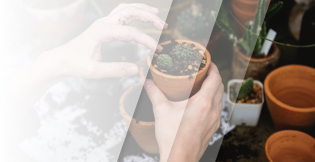Soak-water the plant before potting. If the new pot is made of clay, put it in to soak too. If an old pot is used, wash off all traces of old potting compost. Place a piece of broken pot, or a flat stone, over the drainage hole if it is large.
Put some moist compost into the pot. Gently knock the plant out of the old pot, supporting the root ball on one hand, the pot with the other and tapping the pot edge against the edge of a bench or similar surface.
Try out the root-ball for depth in the new pot. Set it deep enough to allow 2-4 centimetres of rim space for watering, and one centimetre or so to cover existing root-ball with new compost. The bigger the pot the greater should be the watering rim space.
Fill in around the root-ball with new compost and firm gently. Clean the sides of the pot and water the compost lightly. Keep the plant out of direct sunlight for a few days after potting.
March/ April is the best time for potting because the plant gets the full benefit of the growing season. However, potting can continue through the summer until August.
Avoid potting in autumn and winter. There is generally no advantage in potting this late in the year – plants will not grow during that period and there is a risk of root rot diseases developing during the winter months.
Plants need to be re-potted when they outgrow their pots, which depends on the vigour of the plant. Every two or three years is enough for most house plants. The best indication that a plant needs re-potting is the compost drying out very quickly after watering, or the pot toppling over at a touch. Move gradually up through the pot sizes – do not put small plants into large pots.






